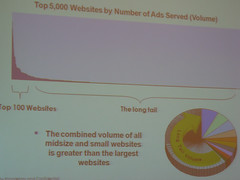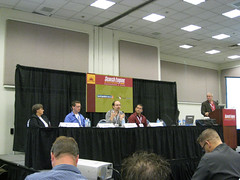What is the long tail in search? It’s all the smaller keyword phrases that refer traffic to your site. There may be only a few referrals, but all the long tail keywords can bring in more traffic and revenue than the larger, more popular keyword phrases.
Long-Tail Example: Head, or larger keyword phrases, could be printers. The long tail contains all the individual makes, models, sizes and types of printers.
What made this session good was that each presenter had a different perspective. Local, ad network, eCommerce and organic search.
Mary Bowling talked about the local perspective. She said that 30-40% of all searches have a local intent. Using the long tail in local SEO is important as each city is different. It’s usually relatively easy to rank for long tail keywords with little optimization efforts. It’s also cheaper to purchase PPC ads and yet can drive more qualified traffic. She says that you can use local long term keywords in local listings and directories and pointed out that Google Maps now allows you to add attributes to your business which can give much additional exposure.
Brock Purpura spoke on an ad network perspective. To best get long tail traffic, you can build your own micro vertical network by contacting 10+ longtail websites. Contact the webmaster to see if you can purchase advertising. Use flat rates and do weekly tests. If it’s successful, lock yourself in for 3-6 months. If not, tweak your ads and try again. Don’t be afraid to get creative and use different sizes, colors and don’t feel that you need to compete against Google.
Aaron Shear had an eCommerce/Shopping perspective. He feels that most shopping sites still depend on PPC rather than organic traffic and it’s a bit sad. Each site already has all the information in their site’s logs, it’s just digging though it all and matching it up. It’s true, long tail traffic is lower when you look at individual phrases, but the conversion and bounce rate is much higher. When thinking about title tags and on-page content, think about what your users are searching for. If necessary, put multiple versions of the product in the title tag. You should be able to optimize for 5 to 20 long tail terms per page. If a site doesn’t have time to optimize for the long tail, they can supplement traffic with a comparison shopping engine. However, learn from what they are doing so that you can use that in the future. Also, look at your affiliate sites to see how they are optimizing for the long tail.
From the organic side, Stephan Spencer tried to summarize his 40 slides as fast as he could. He recommended focusing on scalable tactics and realize that you can’t optimize thousands of pages all at once. His companies research has found that there are about 40 unbranded search for each branded search. This is a ton of long tail keywords. Also about 80-90% of a site’s pages are freeloaders. They are getting indexed and taking up space and development time, but getting no traffic. These are the pages that additional attention should be paid to make them work and get traffic. Stephan also said that shorter URLs get 2x the amount of clicks than long URLs get. Focus on title tags, h1 tags and URLs for quick and easy updates. Also, use the nofollow tag on any links that you don’t want to rank for. Links like ‘page 1, 2, 3″ or ‘previous – next’ as these are not phrases you want visitors coming in on. Stephan still feels that tagging is the most important way to organize, optimize and promote your content.
The long tail is is just one of the many areas in SEO that can hold a goldmine of data. It’s learning how to decipher it and use it that is the hardest part. Even though long tail keywords are not as popular, they can add up to lots of visitors, most of which are ready to convert.
—
Check out all of TopRank’s coverage of SES San Jose and sessanjose08 Photos.




